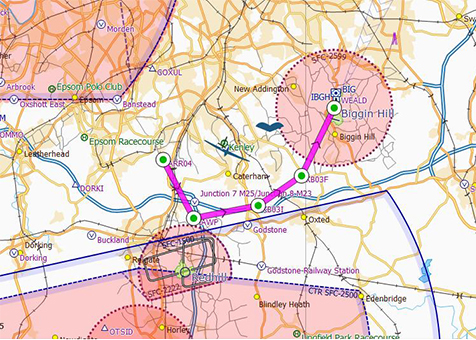This page provides a list of current consultations and proposed regulatory changes. We provide a brief description of the item and a link to the source document. The LAA aims to respond to every consultation on behalf of its members and in their best interest. Where we think it would be useful for LAA members to respond directly to a consultation we say so and why. Of course any member can respond to any consultation but some are very technical and require specialist expertise to understand all the issues. If you want to give the LAA your opinion on any consultation please email us at [email protected] and we will take that into account. We aim to post our draft response here when we can but resource constraints sometimes mean there is little time before the deadline. We will always post our final response here.
Current Issue
Whilst there are many RNAV IFR approach procedures being designed successfully at airfields in Class G airspace, the proposal by Biggin Hill is different. Because it cannot have a straight in approach to runway 03 from the south-west because of the position of the Gatwick CTR/CTA it is proposing an RNAV IFR approach through VFR corridor north of the Gatwick CTR. It will conflict with the stream of VFR aircraft that use that route and have no alternative. This needs your attention.

This is the second consultation, the procedure having been redesigned because Gatwick would not allow the proposed approach to penetrate the CTA because of conflict with Gatwick traffic. Responses to the first consultation which objected on the grounds of collision risk were summarily dismissed by Biggin Hill. They say that because they do not have data on “itinerant VFR aircraft” they cannot assess the risk and therefore dismiss it. You can find their first response document here. See page 29 and 30.
Presently Biggin Hill inbounds for 03 make an ILS approach on runway 21 to join downwind. The first consultation assumed an RNAV approach through the Gatwick CTR and CTA but that has been refused by Gatwick. The new proposed procedure approaches through Class G just north of the Gatwick airspace and turns on to final. You can find the current consultation document here. The procedure is overlaid on the Skydemon VFR chart shown.
Commercial aircraft would descend IFR from altitude 2500ft north of Redhill to be at the final Fix (KB03F) at 1700ft through the area commonly used by VFR aircraft flying at similar altitudes through the Gatwick/Biggin Gap.
Biggin hill says in paragraph 4.5 of its consultation that “there are numerous such procedures around the UK which transit through areas of high-density Visual Flight rules (VFR) operations” and in paragraph 4.6 that “ LBHA revisited the HAZID (Hazard identification) previously carried out for the original IAP configuration, as part of the Safety Management System (SMS) requirements, and applied the same safety analysis processes with similarly-qualified stakeholders. The results derived at the HAZID indicated that the IAP design within the airspace it would operate was tolerably safe" it also notes that “Tolerably safe” is technical terminology used in SMS and HAZID. It provides an acceptable level of safety” Note that in its earlier consultation Biggin Hill dismissed the risk of collision with VFR aircraft because it had no data on them.
You may think that Biggin Hill aircraft using this procedure are likely to collide with VFR aircraft (including you) in the confined gap. Where VFR aircraft carry a transponder Biggin Hill aircraft will receive TCAS Resolution Advisories(RA) requiring them to immediately climb into the Gatwick CTA with the risk of collision with larger aircraft.
You may want to give Biggin Hill your opinion on this by the deadline of 10 April using the response email [email protected]. Please do not copy any of this text; it is for your information only. Write your own response no matter how brief.
3rd April 2017
Status of Notices of Proposed Amendments (NPAs)
Notices of Proposed Amendments - EASA & CAA
Ongoing & Previous Issues
These issues can be found here